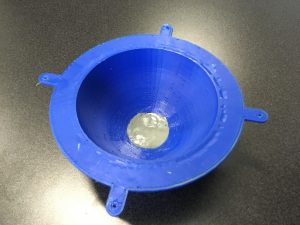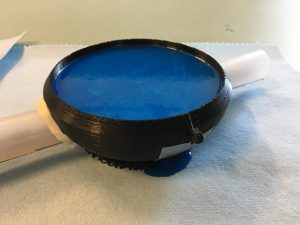Week 11 (March 26-April 1)
Getting resourceful about fixing the mold. Casting the robot. Some more in-depth discussion on user studies.
Fixing the mold
There were a number of problems with the mold, as noted last week:
1) The “outer dome” part of the top mold had some printing errors on the inside
2) Parts of the outer dome were printed with incorrect dimensions, including the holes for screwing the mold pieces together
3) Couldn’t print the cylinder part of the bottom mold
These issues needed to be addressed before casting could begin:
1) The printing had messed up on an internal structure that was supposed to create a water channel in the top of the robot. I decided that it wasn’t too much of an issue, as I figured that we could just cut or drill the water channel after casting the dome. Thus, I simply carved out the extraneous (messy) plastic bits, filled in the holes with Plasticine, and painted the area over with nail polish to prevent the silicone from clinging to the Plasticine (in an experiment we had conducted several weeks earlier while trying to come up with ways to glue silicone pieces together, we had found out that nail polish absolutely does not stick to silicone).
I also did some small-scale testing with a spare piece printed from the same plastic as the mold. The first was to paint over the mold with nail polish and spray it with the release agent, to see if the nail polish would stay on. Next, I cast some silicone with it, to see if removing the silicone would dislodge the nail polish (which would complicate the removal of the dome). These tests indicated that the fixes I made on the mold should work as intended.

The inside of the mold, after fixing.
2) This was a very simple fix; although we didn’t have any larger screws, I managed to find a box of washers and other metal pieces that, when working together, still managed to center the two molds properly.
3) This was a rather tricky one to solve. We decided not to try printing the cylinder again, and instead try to find some other way of making a cylinder that would serve our purposes.
In the end I settled for roughly making a cylinder out of plastic and duct tape. It was a little messier than I would have liked, but it was the best choice given the time constraint – for now I just wanted to make a first prototype to test with, and if we were to continue using this exact mold for future iterations, I would make a higher-fidelity piece out of better (read: not scavenged) material.
The cylinder was also subjected to the same small-scale testing as the nail polish fix, and also passed (but barely; I still had to be careful not to get too much of the release agent under the edges of the duct tape).

The assembled mold for the bottom half, using the makeshift cylinder.
Casting
Came across an interesting and unforeseen issue while assembling the mold for casting: the edges of the bottom mold pieces had not printed out flat. This presented a challenge, as the edges were supposed to be pressed together – in the current state, they could not fit together properly, and there were large gaps in the mold. I ended up sanding the pieces in order to press them together better, but so much sanding was required that the tabs on the mold had wore out, rendering them almost. To circumvent this problem, I had to duct tape the mold together in order for it to keep its shape.

Casting robot bottom.

Casting robot top.
Realized a little bit too late that I had forgotten something during the casting process; the bottom mold was made to be filled to the brim, as part of the design involved having overlapping material to allow the two pieces of the robot to glue together properly. I think it can still work even without the overlap, but I suppose we’ll just have to find out next week.
User studies
Had a long group conversation about possible user studies for all the CuddleBits currently under development. We had originally been entertaining the idea of doing the same study design for all the robots, but it soon became apparent that the various robots were definitely more suited for very different studies.
The tentative conclusion at this time is that the purring CuddleBit is likely best suited for a longitudinal study, where an individual (or several individuals – we are really hoping to be able to settle on a mass-producible version soon) takes the robot home with them, and interacts with it on a daily basis. I am not terribly familiar with this type of study, but it seems to make the most sense, as I had been developing this robot with therapy/companionship in mind – a longitudinal study would allow us to look into long-term interactions with the robot. How would it fit into someone’s daily routine? Would one get tired of it once the novelty wears out? Could it actually become “accepted” by the people interacting with it?